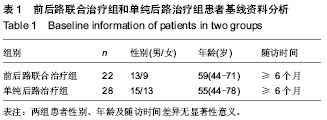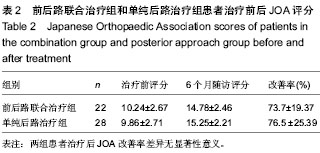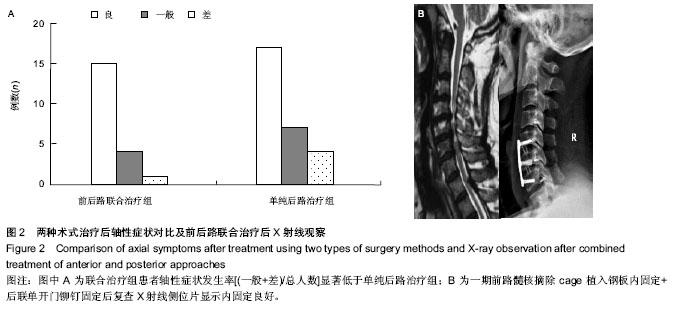| [1] Kawaguchi Y,Matsui H, Ishihara H, et al.Axial symptom safter enbloc cervical laminoplasty. Spinal.1999;12 (5): 2. [2] Wang HQ,Mak KC,Samartzis D,et al.“Spring-back” closure associated with open-door cervical laminoplasty.Spine. 2011; (9):832-838.[3] Cabraja M, Abbushi A,koeppen D,et al.Comparison between anterior and posterior decompression within strumentation for cervical spondylotic myelopathy: sagittal alignment and clinical outcome. Neurosurg Focus. 2010; 28(3):E15. [4] Song KS,Chang BS,Yeom JS,et al.Surgical treatment of severe angular kyphosis with myelopathy:anterior and posterior approach with pedicle screw instrumentation. Spine (Phila Pa 1976). 2008 ;33(11):1229-1235.[5] O’Shaughnessy BA, LiuJC, Hsieh PC, et al. Surgical treatment of fixed cervical kyphosis with myelopathy. Spine. 2008;33( 7) :771-778.[6] 潘胜发,孙宇,朱振军,等.单开门颈椎管扩大椎板成形术后轴性症状与颈椎稳定性的相关观察[J].中国脊柱脊髓杂志,2003, 13(10): 604-607.[7] Nolan JP, Sherk HH. Biomechanical evaluation of the extensor musculature of the cervical spine. Spine.1988; 13(1):9211.[8] Chen G,Luo Z,Nalajala B,et al. Expansive open-door laminoplasty with titanium miniplate versus sutures. Orthopedic.2012;35(4):543-548. [9] Fujibayashi S,Neo M,Yoshida M,et al.Neck muscle strength before and after cervical lamino plasty : relation to axial symptoms.Spinal.2010;23(3):197-202. [10] Takeuchi K, Yokoyama T, Aburakawa S, et al. Axial symptoms after cervical lamino plasty with C3 laminectomy compared with conventional C3-7 laminoplasty a modified laminoplasty preserving the semispinalis cervicis inserted into axis. Spine. 2005;30(22):2544-2549. [11] Kowatari K,Ueyama K,Sannohe A,et al.Preserving the C7 spinous process with its muscles attached effect on axial symptoms after cervical laminoplasty.Orthop Sci.2009;14(3): 279-284. [12] Chen Y, Guo Y, Lu X, et al. Surgical strategy for multilevel severe ossification of posterior longitudinal ligament in the cervical spine. Spinal. 2011;24(1): 24-30.[13] Grosso MJ, Hwang R, Mroz T, et al. Relationship between degree of focal kyphosis correction and neurological outcomes for patients undergoing cervical deformity correction surgery. J Neurosurg Spine. 2013;18(6):537-544[14] Du W, Wang L, Shen Y, et al. Long-term impacts of different posterior operations on curvature, neurological recovery and axial symptoms for multilevel cervical degenerative myelopathy. European Spine Journal.2013;22(7): 1594-1602.[15] Lebl DR, Hughes A, Cammisa Jr FP, et al. Cervical spondylotic myelopathy: pathophysiology, clinical presentation, and treatment. HSS journal.2011;7(2): 170-178.[16] Fujibayashi S, Neo M, Yoshida M, et al. Neck muscle strength before and after cervical laminoplasty: relation to axial symptoms. J Spinal Disord Tech. 2010, 23(3): 197-202.[17] Tetreault LA, Dettori JR, Wilson JR, et al. Systematic Review of Magnetic Resonance Imaging Characteristics That Affect Treatment Decision Making and Predict Clinical Outcome in Patients With Cervical Spondylotic Myelopathy. Spine.2013; 38(22S): S89-S110.[18] Kerkovský M, Bednarík J, Dušek L, et al. Magnetic resonance diffusion tensor imaging in patients with cervical spondylotic spinal cord compression: correlations between clinical and electrophysiological findings. Spine.2012;37(1): 48-56.[19] Highsmith JM, Dhall SS, Haid Jr RW, et al. Treatment of cervical stenotic myelopathy: a cost and outcome comparison of laminoplasty versus laminectomy and lateral mass fusion: Clinical article. J Neurosurg Spine. 2011;14(5): 619-625.[20] 贾小林,谭祖键,杨阜滨,等.相邻两节段脊髓型颈椎病前路不同术式的比较[J].中国矫形外科杂志, 2012, 20(21): 1931-1934.[21] 唐向盛,谭明生,移平,等.多节段脊髓型颈椎病前路手术疗效分析[J].中国骨伤, 2013(6): 460-463.[22] 杜艳霞,谢菲. 198例脊髓型颈椎病前路手术早期并发症的观察及护理[J].天津护理, 2011, 18(6): 331-332.[23] 李玉伟,王海蚊,王玉记,等.后路单开门与’期前后路手术减压治疗前后受压脊髓型颈椎病的疗效比较[J].中国脊柱脊髓杂志, 2010, 20(3):197-200.[24] 孙皓,姚宇,张宇峰.颈椎后路单开门椎管成形术治疗颈椎管狭窄合并脊髓型颈椎病[J].吉林医学, 2011, 32(10): 1978-1979.[25] 祁文,刘汝专,潘汉升,等.一期前后路手术治疗多节段脊髓型颈椎病[J].中国骨与关节损伤杂志, 2011, 26(5): 421-422.[26] 陈兵.采用颈前路减压内固定治疗脊髓型颈椎病临床分析[J]. 中国当代医药, 2012,18(5): 172-173.[27] 张曼丽,朱丽娟,谭清华.前后路联合手术治疗脊髓型颈椎病的手术配合[J].全科护理, 2010, 8(1): 206-207.[28] 魏新荣,移平,谭明生,等. “锚定法”单开门椎管成形术治疗脊髓型颈椎病52例分析[J].中国误诊学杂志, 2010 (7): 1674-1675.[29] Herkowitz HN,Kurz LT,over holt DP.surgical management of cervicai soft disc herniation.A comparision between the anterior and posterior approach. Spine.1990;15(10): 1026-1030.[30] Kong Q, Zhang L, Liu L, et al.Effect of the decompressive extent on the magnitude of the spinal cord shift after expansive open-door laminoplasty. Spine.2011;36(13): 1030-1036.[31] Sakaura H, Hosono N, Mukai Y, et al. C5 palsy after decompression surgery for cervical myelopathy: review of the literature. Spine.2003;28(21): 2447-2451.[32] 钟炯彪, 李捷一. 颈前路椎体次全切植骨钛板固定治疗脊髓型颈椎病疗效分析[J].中国现代医生, 2013, 51(4): 30-32.[33] 柳扬,孙永青,崔准,等.颈椎管容积与颈脊髓体积比值与脊髓型颈椎病病变程度的相关性分析[J].中国骨与关节外科, 2013 (3): 243-246.[34] 阿不都,沙拉木, 努尔拉.颈椎前后路联合术治疗脊髓型颈椎病的临床疗效观察[J].中国医药导报, 2013, 10(4): 36-38.[35] 温世锋,郭东明,徐中和,等.微型钛板与锚定法颈椎单开门治疗颈椎病效果的对比研究[J].中国临床解剖学杂志, 2013, 31(003): 350-352.[36] 苏洪民,房清敏,孙兆忠,等.颈椎后路单开门椎管扩大成形术+单侧侧块钉棒系统内固定术治疗脊髓型颈椎病110例疗效观察[J].滨州医学院学报,2013,36(2):105-108. |



.jpg)